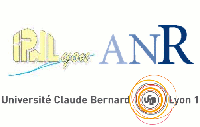Orateur
Mlle
Valentyna Mokina
(Institute for Nuclear Research, MSP 03680 Kyiv, Ukraine)
Description
During the last decade there has been a steady increase in the research activity towards the developments of new scintillation materials for their use in the cryogenic detectors. These detectors play important role in the experiments searching for rare events, such as Dark Matter, and neutrinoless double beta decay. There is need in variety of scintillation targets and therefore the measurement of the scintillation characteristics at low temperatures is an important objective allowing to assess the suitability of the material for cryogenic applications.
Relative intensity and scintillation decay kinetics were studied in CaWO4, CaMoO4, ZnWO4, ZnMoO4, PbWO4, PbMoO4, MgWO4, ZnSe, and LiF(W) crystal scintillators over the temperature range 7 – 310 K. Samples of the crystals 5*5*1 mm of size were placed into an optical cryostat and excited with an 241Am alpha-source. The measurements where carried out using the multiple photon counting technique and a green sensitive photomultiplier as a detector. The following values of relative intensity were obtained at the temperature T=7 K (prior spectral correction): CaWO4 (100%), ZnWO4 (77%), ZnSe (61%), CaMoO4 (46%), PbWO4 (24%), PbMoO4 (21%), MgWO4 (15%), LiF(W) (<5%), and ZnMoO4 (<5%).
Author
Mlle
Valentyna Mokina
(Institute for Nuclear Research, MSP 03680 Kyiv, Ukraine)
Co-auteurs
A. Nikolayko
(Institute for Nuclear Research, MSP 03680 Kyiv, Ukraine)
A. Shekhovtsov
(Institute for Single Crystals, 61001 Kharkiv, Ukraine)
B. Grinyov
(Institute for Scintillation Materials, 61001 Kharkiv, Ukraine)
D. Spassky
(Skobeltsyn Institute of Nuclear Physics, Moscow State University, 119992 Moscow, Russia)
E. Galashov
(Nikolaev Institute of Inorganic Chemistry, 630090 Novosibirsk, Russia)
F. Danevich
(Institute for Nuclear Research, MSP 03680 Kyiv, Ukraine)
H. Kraus
(University of Oxford, Department of Physics, Keble Road, Oxford OX1 3RH, UK)
I. Tupitsyna
(Institute for Single Crystals, 61001 Kharkiv, Ukraine)
L. Ivleva
(General Physics Institute, Russian Academy of Sciences, 119991 Moscow, Russi)
L. Nagornaya
(Institute for Single Crystals, 61001 Kharkiv, Ukraine)
L. Potkin
(All-Russian Research Institute for Synthesis of Materials (VNIISIMS), Alexandrov, Vladimir region, Russia)
M. Kosmyna
(Institute for Single Crystals, 61001 Kharkiv, Ukraine)
M. Pashkovskii
(Dep. of Semiconductors Physics, Ivan Franko National University, 79005 Lviv, Ukrain)
N. Krutyak
(Skobeltsyn Institute of Nuclear Physics, Moscow State University, 119992 Moscow, Russia)
O. Shkulkova
(Institute for Nuclear Research, MSP 03680 Kyiv, Ukraine)
R. Boiko
(Institute for Nuclear Research, MSP 03680 Kyiv, Ukraine)
S. Nagorny
(Institute for Nuclear Research, MSP 03680 Kyiv, Ukraine)
V. Goriletsky
(Institute for Scintillation Materials, 61001 Kharkiv, Ukraine)
V. Mikhailik
(University of Oxford, Department of Physics, Keble Road, Oxford OX1 3RH, UK)
V. Shlegel
(Nikolaev Institute of Inorganic Chemistry, 630090 Novosibirsk, Russia)
Ya. Vasiliev
(Nikolaev Institute of Inorganic Chemistry, 630090 Novosibirsk, Russia)

